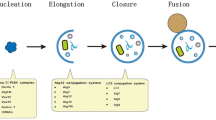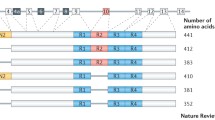Abstract
Tau protein is a predominantly neuronal microtubule-associated protein that is enriched in axons and is capable of promoting microtubule assembly and stabilization. In the present article we review some of the key experiments directed to obtain insights about tau protein function in developing neurons. Aspects related to whether or not tau has essential, unique, or complementary functions during axonal formation are discussed.
Similar content being viewed by others
REFERENCES
Mitchison, T., and Kirschner, M. W. 1988. Cytoskeletal dynamics and nerve growth. Neuron 1:761-772.
Kirschner, M., and Mitchison, T. 1986. Beyond self-assembly: from microtubules to morphogenesis. Cell 45:329-342.
Lee, G. 1993. Non-motor microtubule-associated proteins. Curr. Op. Cell Biol. 5:88-94.
Avila, J., Dominguez, J., and Diaz-Nido, J. 1994. Regulation of microtubule dynamics by microtubule-associated protein expression and phosphorylation during neuronal development. Int. J. Dev. Biol. 38:13-25.
Maccioni, R., and Cambiazo, V. 1995. Role of microtubule-associated proteins in the control of microtubule assembly. Physiol. Rev. 75:835-864.
Brady, S., and Sperry, A. 1995. Biochemical and functional diversity of microtubule motors in the nervous system. Curr. Op. Neurobiol. 5:551-558.
Hirokawa, N. 1998. Kinesin and dyenin superfamily proteins and the mechanism of organelle transport. Science 279:519-526.
Kosik, K. S. 1997. Tau structure and function; in pages 43-52; J. Avila, R. Brandt, and K. S. Kosik) (eds.) Brain Microtubule Associated Proteins Amsterdam Harwood Academic Publishers.
Weingarten, M., Lockwood, A., Hwo, S-Y., and Kirschner, M. 1976. A protein factor essential for microtubule assembly. Proc. Natl. Acad. Sci. USA 72:1858-1862.
Binder, L., Frankfurter, A., Rebhun, L. 1985. The distribution of tau in the mammalian central nervous system. J. Cell Biol. 101:1371-1378.
Ferreira, A., Busciglio, J., and Caceres, A. 1989. Microtubule formation and neurite growth in cerebellar macroneurons which develop in vitro: Evidence for the involvement of the microtubule-associated proteins MAP-1a, HMW-MAP2 and Tau. Dev. Brain Res. 49:215-228.
Black, M., Slaughter, T., Moshiach, S., Obrocka, M., Fisher, I. 1996. Tau is enriched on dynamic microtubules in the distal region of growing axons. J. Neurosci. 16:3601-3619.
Papasozomenos, Ch., and Binder, L. 1987. Phosphorylation determines two distinct species of tau in the central nervous system. Cell Motil. Cytoskel. 8:210-226.
Ferreira, A., Busciglio, J., and Caceres, A. 1987. An immunocytochemical analysis of the ontogeny of the microtubule-associated protein MAP-2 and Tau in the nervous system of the rat. Dev. Brain Res. 34:9-31.
Brandt, R., and Lee, G. 1993. Functional organization of microtubule-associated protein tau: Identification of regions which affect microtubule growth, nucleation, and bundle formation in vitro. J. Biol. Chem. 268:3414-3419.
Brandt, R., Leger, J., and Lee, G. 1995. Interaction of tau with the neural plasma membrane mediate by tau's aminoterminal domain. J. Cell Biol. 131:1327-1340.
Trinczek, B., Biernat, J., Baumann, K., Mandelkow, E., and Mandelkow, E. 1995. Domains of tau protein, differential phosphorylation, and dynamic instability of microtubules. Mol. Biol. Cell 6:1887-1902.
Drechsel, D., Hyman, A., Cobb, M., and Kirschner, M. 1992. Modulation of the dynamic instability of tubulin assembly by the microtubule-associated protein tau. Mol. Biol. Cell 3: 1141-1154.
Drubin, D., and Kirschner, M. 1986. Tau protein function in living cells. J. Cell Biol. 103:2739-2746
Kanai, Y., Takemura, R., Oshima, T., Mori, H., Ihara, Y., Yanagisawa, M., Masaki, T., and Hirokawa, N. 1989. Expression of multiple tau isoformas and microtubule bundle formation in fibroblasts transfected with a single tau cDNA. J. Cell Biol. 109:1173-1184.
Kanai, Y., Chen, J., and Hirokawa, N. 1992. Microtubule bundling by tau proteins in vivo: analysis of functional domains. EMBO J. 11:3953-3961.
Lee, G., and Rook, S. 1992. Expression of tau protein in nonneuronal cells: microtubule bundling and stabilization. J. Cell Sci. 102:227-237.
Drubin, D. G., Feinstein, S. C., Shooter, E. M., and Kirschner, M. 1985. Nerve growth factor-induced neurite outgrowth in PC12 cells involves the coordinate induction of microtubule assembly and assembly promoting factors. J. Cell Biol. 101:1799-1807.
Esmaeli-Azad, B., McCarty, J., and Feinstein, S. C. 1994. Sense and antisense transfection analysis of tau function: tau influences net microtubule assembly, neurite outgrowth and neurite stability. J. Cell Sci. 107:869-879.
Caceres, A., and Kosik, K. 1990. Inhibition of neurite polarity by antisense oligonucleotides in primary cerebellar neurons. Nature 343:461-463.
Ferreira, A., and Caceres, A. 1989. The expression of acetylated microtubules during axonal and dendritic growth in cerebellar macroneurons which develop in vitro. Dev. Brain Res. 49:205-213.
DiTella, M., Feiguin, F., Carri, N., Kosik, K., and Caceres, A. 1996. MAP1B/tau functional redundancy during laminin-enhanced axonal growth. J. Cell Sci. 109:467-477.
Caceres, A., Mautino, J., and Kosik, K. 1992. Suppression of MAP-2 in cultured cerebellar macroneurons inhibits minor neurite formation. Neuron 9:607-618.
Hanemaaijer, R., and Ginzburg, I. 1991. Involvement of mature tau isoforms in the stabilization of neurites in PC12 cells. J. Neurosci. Res. 30:163-171.
Leger, J. G., Brandt, R., and Lee, G. 1994. Identification of tau protein regions required for process formation in PC12 cells. J. Cell Sci. 107:3403-3412.
Knops, L., Kosik, K., Lee, G., Pardee, J., Cohen-Gould, L., and McColongue, L. 1991. Overexpression of tau in nonneuronal cell induces long cellular processes. J. Cell Biol. 114: 725-734.
Chen, J., Kanai, Y., Cowan, N., and Hirokawa, N. 1992. Projection domains of MAP1 and tau determine spacings between microtubules in dendrites and axons. Nature 360:674-677.
Baas, P. W., Pienkowski, T., and Kosik, K. 1991. Processes induced by tau expression in Sf9 cells have an axon-like microtubule organization. J. Cell Biol. 115:1333-1344.
Lee, G., Newman, T., Gard, D., Band, P., and Panchamoorthy, G. (1998) Tau interacts with src-family non receptor tyrosine kinases. J. Cell Sci. 111:3167-3177.
Bixby, J., and Jhabvala, P. 1993. Tyrosine phosphorylation in early embryonic growth cones. J. Neurosci. 13:3421-3432.
Helmke, S., and Pfenninger, K. 1996. Growth cone enrichment and cytoskeletal association of non-receptor tyrosine kinases. Cell Motil. Cytoskel. 30:194-207.
Wu, D., and Goldberg, D. 1993. Regulated tyrosine phosphorylation at the tips of growth cone filopodia. J. Cell Biol. 123:653-64.
Lohse, K., Helmke, S., Wood, M., Quiroga, S., de la Houssaye, B., Miller, V., Negre-Aminou, P., and Pfenninger, K. 1996. Axonal origin and purity of growth cones isolated from fetal rat brain. Dev. Brain Res. 96:83-96.
Beggs, H., Soriano, P., and Maness, P. 1994. NCAM-dependent neurite outgrowth is inhibited in neurons from fyn-minus mice. J. Cell Biol. 127:825-833.
Ignelzi, M., Miller, D., Soriano, P., and Maness, P. 1994. Impaired neurite outgrowth of src-minus cerebellar neurons on the cell adhesion molecule L1. Neuron 12:873-884.
Mandell, J., and Banker, G. 1995. The microtubule cytoskeleton and the development of neuronal polarity. Neurobiol. Aging 16:229-237.
Mandell, J., and Banker, G. 1996. Microtubule-associated proteins, phosphorylation gradients and the establishment of neuronal polarity. Perspect. Dev. Neurobiol. 4:125-135.
Kempf, M., Clement, A., Faissner, A., Lee, G., and Brandt, R. 1996. Tau binds to the distal axon early in development of polarity in a microtubule-and microfilament-dependent manner. J. Neurosci. 16:5563-5592.
DiTella, M., Feiguin, F., Morfini, G., and Caceres, A. 1994. Microfilament-associated growth cone component depends upon Tau for its intracellular localization. Cell Motil. Cytosk. 29: 117-130.
Harada, A., Oguchi, K., Okabe, S., Kuno, J., Terada, S., Ohshima, T., Sato-Yoshitake, R., Takel, Y., Noda, T., and Hirokawa, N. 1994. Altered microtubule organization in small calibre axons of mice lacking tau protein. Nature 369:488-491.
Chamack, B., and Prochiantz, A. 1988. Influence of extracellular matrix proteins on the expression of neuronal polarity. Development 106:483-491.
Lein, P. J., and Higgins, D. 1989. Laminin and a basement membrane extract have different effects on axonal and dendritic outgrowth fro embryonic rat sympathetic neurons in vitro. Dev. Biol. 136:330-345.
Lein, P. J., Banker. G., and Higgins, D. 1992. Laminin selectively enhances axonal growth and accelerates the development of polarity by hippocampal neurons in culture. Dev. Brain Res. 69:191-197.
Lochter, A., and Schachner, M. 1993. Tenascin and extracellular matrix glycoproteins: From promotion to polarization of neurite growth in vitro. J. Neurosci. 13:3986-4000.
Tint. I., Slaughter, T., Fisher, I., and Black, M. 1998. Acute inactivation of tau has no effect on dynamics of microtubules in growing axons of cultured sympathetic neurons. J. Neurosci. 18:8660-8673.
Brown, A., Slaughter, T., and Black, M. 1992. Newly assembled microtubules are concentrated in the proximal and distal regions of growing axons. J. Cell Biol. 119:867-882.
Li, Y., and Black, M. 1996. Microtubule assembly and turnover in growing axons. J. Neurosci. 16:531-544.
Lovestone, S., and Reynolds, C. H. 1997. The phosphorylation of tau: a critical stage in neurodevelopment and neurodegenerative processes. Neuroscience 78:309-324.
Kaech, S., Ludin, B., and Matus, A. 1996. Cytoskeletal plasticity in cells expressing neuronal microtubule-associated proteins. Neuron 17:1189-1199.
Brugg, B., and Matus, A. 1988. PC12 cells express juvenile microtubule-associated proteins during nerve growth factor-induced neurite outgrowth. J. Cell Biol. 107:643-650.
Brugg, B,, Reddy, D., and Matus, A. 1993. Attenuation of microtubule-associated protein 1B expression by antisense oligodeoxinucleotides inhibits initiation of neurite outgrowth. Neuroscience 52:489-496.
Sato-Yoshitake, R., Shiomura, Y., Miyasaka, H., and Hirokawa, N. 1989. Microtubule-associated protein 1B: Molecular structure, localization, and phosphorylation-dependent expression in developing neurons. Neuron 3:229-238.
Ferreira, A., and Caceres, A. 1991. Estrogen-enhanced neurite growth: Evidence for a selective induction of Tau and stable microtubules. J. Neurosci. 11:392-400.
Ferreira, A., Busciglio, J., Landa, C., and Caceres, A. 1990. Ganglioside-enhanced neurite growth: Evidence for a selective induction of high molecular weight MAP2. J. Neurosci. 10: 293-302.
Pigino, G., Paglini., G., Ulloa, L., Avila, J., and Caceres, A. 1997. The expression and function of cdk5 during process extension in primary cultured neurons. J. Cell Sci. 110:257-270.
Paglini, G., Pigino, G., Morfini, G., Kunda, P., Maccioni, R., Quiroga, S., Ferreira, A., and Caceres, A. 1998. Evidence for the participation of the neuron-specific activator p35 during laminin-enhanced axonal growth. J. Neurosci. 18:9858-9869.
Takei, Y., Kondo, S., Harada, A., Inomata, S., Noda, T., and Hirokawa, N. 1997. Delayed development of nervous system in mice homozygous for disrupted microtubule-associated protein 1B (MAP1B) gene. J. Cell Biol. 137:1615-1626.
Takei, Y., Junlin, T., Harada, A., Inomata-Terada, S., and Hirokawa, N. 1998. Mol. Biol. Cell 9:394a.
Author information
Authors and Affiliations
Rights and permissions
About this article
Cite this article
Paglini, G., Peris, L., Mascotti, F. et al. Tau Protein Function in Axonal Formation. Neurochem Res 25, 37–42 (2000). https://doi.org/10.1023/A:1007531230651
Issue Date:
DOI: https://doi.org/10.1023/A:1007531230651




